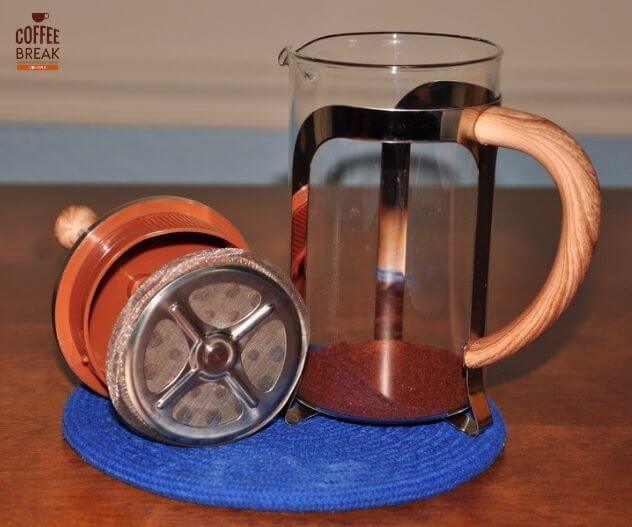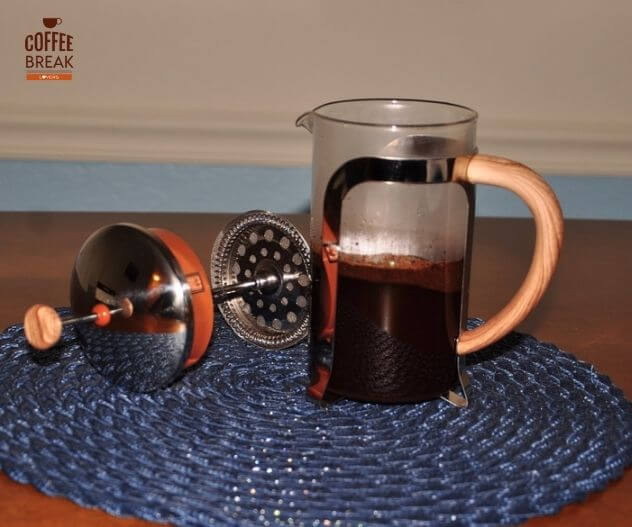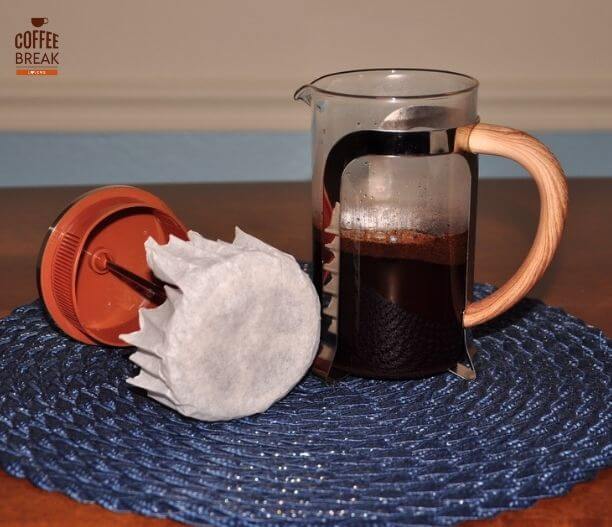French Presses are known for making rich and full-bodied coffee. But they’re also known for leaving sludge in your cup, which causes a lot of people to avoid this brewing method. So, why does sludge get in your French Press coffee and what can you do about it?
Generally, sludge or sediment appears in French Press coffee because some of the coffee grinds are so small they can pass through the filter screen. This typically happens because you didn’t grind your beans coarse enough, or more likely, your grinder doesn’t grind the coffee beans uniformly.
In most cases, this can be fixed by adjusting your grind size or by getting a burr grinder that can grind beans uniformly. But in other cases, you may have to modify your French Press brewing technique.
Why Is Sludge In My French Press Coffee?
Sludge or sediment generally appears in your coffee because some of the coffee grinds were too small to be stopped by your French Press’ mesh filter.
These small grinds are usually caused by one of two things:
- You chose a grind that’s too small for a French Press or
- Your grinder doesn’t grind your beans uniformly
Sludge Can Appear If Your Coffee Beans Were Ground Too Fine
Typically, a medium to coarse grind is recommended for French Press coffee. If you choose to grind your beans finer than this, you could easily end up with fine coffee sediment remaining at the bottom of your cup.
Besides that, you could also run into difficulty pressing down the plunger due to increased surface tension.
(If you want to know more about what can happen if your French Press is hard to push, check out our post Why Do French Presses Explode?)
Sludge Can Appear If Your Coffee Wasn’t Ground Uniformly
Even if you use a coarse grind, sludge can still appear in your cup if your coffee beans are not ground uniformly.
This commonly happens if you use a blade grinder. Since blade grinders literally chop your beans up, they break apart into randomly-shaped pieces. Some will end up larger and others will be fine like powder.
It’s these powdery pieces that can easily slip through the mesh filter and create sludge at the bottom of your coffee.
On the other hand, burr grinders are more likely to give you the uniform grind you want. It won’t be perfect and there will still be a few powdery pieces, but it’ll be far less than if you used a blade grinder.

Will Reducing Coffee Sludge Improve My Coffee’s Flavor?
Reducing coffee sludge will remove some negative flavors, but it will also remove some desirable flavors as well.
The sludge in French Press coffee is made of mostly powdered coffee grinds, coffee oils, and water. The coffee grinds themselves will definitely have a muddying effect on your coffee. However, the oils have a lot of desirable flavors.
Since the French Press is an immersion method, the point is to extract the coffee’s solubles directly into the water. This is what gives French Press coffee its characteristically rich and full-bodied profile.
But as your coffee sits, those coffee solubles that weren’t completely dissolved will settle to the bottom of your cup along with the fine coffee grinds and create sludge.
So, while the sludge does contain powdered coffee grinds that slipped through the filter, it also contains other solubles that give your coffee a robust flavor.
Will Reducing Coffee Silt Make My Coffee Healthier?
Studies have shown that the oily coffee sediment at the bottom of your cup may raise your cholesterol levels. So, reducing it as much as possible could make your coffee healthier.
Coffee contains various compounds that can affect the body in different ways. Some of these compounds are known as diterpenes (cafestol and kahweol) which are found in coffee oils.
Research suggests that there’s a link between consuming diterpenes and higher levels of LDL cholesterol.
And because a French Press doesn’t filter out oils or other coffee solubles, it contains 30 times more diterpenes than filtered coffee.
So, the more you can reduce the sediment and oil in your coffee, the healthier your coffee will be.
How Do You Stop Sludge In French Press Coffee
If you want to prevent coffee silt from getting into your cup, there are a few things you can try.
Specifically, try changing
- your grind
- your filtering technique
- your brewing technique
1. Use A Coarser Grind For Less Coffee Sludge
Sludge at the bottom of your French Press coffee could be the result of you using grinds that are too fine.
A medium to coarse grind is recommended for French Presses. But many people have favorite brands that pre-grind the coffee. Or they may prefer a finer grind because it allows more extraction.
If either of these is your situation, try testing out a coarser grind and see if that reduces the sludge in your coffee.
2. Buy A Burr Grinder To Get A Uniform Grind
You may already be using a coarse grind, but if you’re using a blade grinder your coffee may not be uniformly sized.
When you have coffee grinds of different sizes, the smallest pieces are what slip through the filter to create sediment in your coffee. To reduce this, try switching to a burr grinder.
If you are looking for a burr grinder check out Cuisinart DBM-8 on Amazon.
Cuisinart DBM-8 Supreme Grind Automatic Burr Mill
- Provides uniform grind consistently
- 18 grind selector position from ultra-fine to coarse
- 6 settings for every type of grind you choose
- Easy to use and clean
3. Don’t Disturb The Sediment By Pressing The Plunger
One of the reasons coffee sludge appears is that the coffee grinds don’t have enough time to settle.
After adding the hot water to the coffee grinds, they will need a few minutes to drift back down to the bottom of the coffee maker. If you pour your coffee before that happens, the grinds that are still floating in the water will inevitably find their way into your cup.
Also keep in mind that when you press the plunger, you’re agitating the water. So even if the grinds did have enough time to float to the bottom, as soon as you press, you’re kicking up the sediment again.
The best option here is to place the mesh filter right on the surface of the water and let your coffee steep. When you’re ready to pour, don’t press the plunger.
Simply let the mesh filter act as a strainer to keep any stray grinds out of your cup.
4. Use A Paper Coffee Filter To Keep Sludge Out Of Your Cup
Another option to keep coffee sludge out of your cup is to use a paper coffee filter.
We’ve tried this method before and can vouch that it really does keep the sludge out of your coffee.
- Step 1: Boil your water and grab your coffee grounds
- Step 2: Put the coffee grounds in your French Press

- Step 3: Add the hot water to your French Press

- Step 4: Stir the grinds in the water and let it steep for 4 minutes
- Step 5: Place a paper filter over your French Press’ mesh filter

- Step 6: Slowly press the plunger until the filter is at the bottom
- Step 7: Pour your sludge-free coffee into a cup

While this method will keep the sludge out of your coffee, it will also keep out a lot of the coffee oils and other solubles. (Which will affect the flavor while making it healthier.)
Related Posts:
- Is Cuban Coffee Stronger Than Regular Coffee: Proof Inside!
- Should You Tamp a Moka Pot: Here’s What You Need to Know!
5. Try The French Pull Method To Keep Sludge Out Of Your Coffee
For the French Press method, you’d normally put the ground coffee in the French Press, then pour hot water on top and finally press the coffee after it’s brewed.
The French Pull method works the opposite way. (But you’ll need to be able to remove the lid from your plunger for it to work.)
- Step 1: Remove the lid from your French Press filter
- Step 2: Press the lidless filter down into the French Press
- Step 3: Pour the coffee grounds on top of the filter
- Step 4: Pour your hot water on top of the grounds and let steep for 4 minutes
- Step 5: Carefully pull the plunger up and out of the French Press. (You may need to clean the rim before pouring your coffee)
We’ve heard people say that this method reduces the sludge in your coffee, but we haven’t yet tried this one for ourselves.
6. Try The Hoffman French Press Technique
The Hoffman Technique is similar to the normal French Press method, but it’s much longer and results in a cleaner cup of coffee.
- Step 1: Boil your water and place medium size coffee grinds in your French Press
- Step 2: Pour your hot water over the coffee grinds and let it sit for 4 minutes
- Step 3: Stir the grinds floating on top and scoop off the foam and grinds that don’t fall to the bottom of the French Press
- Step 4: Let it sit for another 5 minutes
- Step 5: Place the mesh filter right on the surface of the coffee without pressing it.
- Step 6: Carefully pour the coffee into a cup and allow the filter to act as a strainer.
We’ve tried this technique a number of times before and can vouch that your coffee will be clear and pretty much sludge-free if you do it right.
Key Takeaways
- Coffee sludge is in your coffee because fine, powdery coffee grinds slip through your French Press filter. To fix this try using a coarser grind or a burr grinder.
- The fine grinds in the coffee sludge can have a negative impact on your coffee’s flavor. However, this same sludge has a lot of oils that do have desirable flavors.
- French Press coffee contains a lot more coffee oils which may raise LDL cholesterol
- To reduce sludge in your coffee, consider using a paper filter, giving your coffee time to settle and not plunging your coffee.
Cheers Coffee Lovers!

KEEP READING
- Is Arabica Or Robusta Best For Cold Brew Coffee?

- Why Is My Espresso Puck Wet? (The 6 Most Common Reasons)

- How To Make Cuban Coffee Without A Moka Pot? (3 Options!)

- Does Cold Brew Break A Fast? Things To Consider!

- Can I Use Coffee Grounds Twice? (Here Are Our Results!)

- What’s The Best Grind Size For A Moka Pot? Ultimate Guide!


Oliver is co-owner of Coffee Break Lovers. The only thing he loves more than the process of brewing coffee is drinking it.


